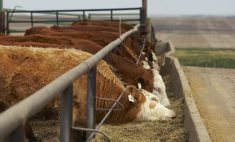There have been volumes written on antimicrobial resistance (AMR) in the last several years. And it is important to remember just how good the Canadian cattle industry is doing in managing AMR and look to future changes veterinarians may make in their recommendations.
For those of you craving more detailed information, there have been several very good brochures published and websites established providing factual and current information on the subject. This knowledge is important anytime we try to explain to the average urbanite what we know and how the entire industry is really following the guidelines about prudent usage of antimicrobials.
Read Also

Canadian Beef Check-Off Agency reports on investments and activities
The check-off agency’s work behind the scenes is what ensures cattle check-off dollars are invested wisely, accounted for transparently and deliver measurable value back to producers and importers.
We hear the public and some industry sectors use terms like “raised without antibiotics.” The fact is, reducing antibiotic use can have severe ramifications from an animal welfare perspective. They are effective and safe. We have established withdrawal periods by law so there are no antibiotic or other drug residues from products such as NSAIDs or vaccines in our meat or milk. The established withdrawal times are set for each product.
The best printed brochure I have seen is the “Worried about Antibiotic Use and Resistance in Cattle” put out by the Alberta Beef Producers and available for anyone across Canada. It explains the four main categories of antimicrobials including Category One products, which also have very high importance in human medicine. They give examples of products we use in cattle like Excede or Baytril. This category makes up less than one to two per cent of the antimicrobials used in cattle production. But we must still think twice before we use them and only use the Category One drugs for treatment of severe medical conditions like a bad pneumonia.
Veterinarians continually advise on the least-critical product category that is still likely to be effective on the condition at hand.
I believe veterinarians, when they are doing autopsies, are doing more culture and sensitivities tests, especially when dealing with cases that have been unresponsive to drugs that previously worked.
This means the lab grows the bacteria causing the illness and uses little discs impregnated with antibiotics to actually see which ones work. This gives us a much better scientific approach to treatment and should provide a higher success rate. The issue is it can take a couple of days to test and get results, so in the meantime we as veterinarians must prescribe a treatment often based on previous protocols and success rates.
Very low risk
The possibility of getting resistant bacteria from cattle to humans is very remote because first very few Category One drugs are used. Plus the resistant bacteria would need to get through the packing plant and all the sanitary precautions used such as steam sterilization, UV light and a very clean environment through the cooking process. The bacteria have to survive all that, then get into a human who has been prescribed the same antibiotic by the doctor. This is a very, very unlikely chain of events.
There is now a research cluster led by researcher Dr. Tim McCallister at Agriculture Canada’s Lethbridge Research Centre, together with researchers from the cattle industry and veterinary colleges, looking at all these potential pathways. The teams is looking at all possibilities and finding very positive evidence the industry is doing its due diligence to protect both livestock production and humans. A great quote from veterinarian Dr. Craig Dorin of Airdrie: “It is our privilege and not our right to be able to use antibiotics in the animals we take care of.”
In all the surveillance being done in the industry, drug resistance levels are very low in beef. That doesn’t mean, however, they can’t increase. If resistance is found, the bacteria are resistant to most antibiotics in the same family of drugs. Veterinarians know this and will prescribe a different family of antibiotics as needed.
Today veterinarians are much more involved with antimicrobials that are used in production animal medicine, especially non-prescription products commonly administered in the feed or water. More than 75 per cent of the drugs are used in feed, so enhanced oversight at this level is where you as producer will see the most changes.
These are all positive steps in reducing overall antibiotic usage where possible and using the most effective ones for the condition at hand.
Good management practices important
Among the first steps — growth-promotant indications are being removed from antibiotic labeling this year. Most growth-promotant products contain antibiotics and often it is the reduced disease incidence that results in increased growth as a secondary benefit. But going forward this will require your veterinarian having a medical reason to prescribe the products.
More good information is available on the Beef Cattle Research Council (BCRC) website at www.beefresearch.ca/amr. Along with reading material the site also offers a seven minute video that is worth watching by everyone in the cattle industry.
Producers (and veterinarians) need to get back to management practices that we have known will minimize sickness and hence reduce antibiotic usage. For example, calves receiving adequate quality and quantity of colostrum (colostrum is the best “drug” one can use), low-stress weaning and preimmunization of calves up to two weeks before weaning are practices which reduce the need for treatment.
More direct movement of cattle through satellite and Internet sales is another measure that eliminates lots of commingling and risk of disease spread. These practices can definitely reduce the cost and usage of antimicrobials. In some ways I know it is easier said then done, but the potential for reduction in antimicrobial usage is great.
The pharmaceutical companies are focusing more on vaccinology so you will see broader coverage vaccines for viruses and bacteria. Intranasal vaccines can provide quicker coverage and technology has and will improve the degree of immunity and length of coverage over time. The future will most likely see more vaccines replacing the antimicrobials. It is far better to prevent by management and vaccination than treat with antibiotics.
Also pay attention to parasite treatments. Reducing parasite pressure in your herd will also stimulate the cattle’s own natural immune system. That, along with proper nutrition helps to minimize sickness.
With increased usage of antibiotics there is increased risk of selecting for resistance in that species. The oversight of veterinary communities will focus on four things — prevention, production, control and therapy. Another website has been built by the Alberta Veterinary Medical Association (ABVMA) found at: www.raisedwithcare.ca.
This very interactive website offers some quizzes to test your knowledge. The questions you get wrong become an educating experience.
I encourage everyone to check out these reference sources and inform the public. As we all work together in the cattle industry to do the right thing we can be leaders and educators in helping with the global battle against AMR.
Generally speaking we are already doing a good job but there is always room for improvement. Question your veterinarian and yourself if there is a better way the next time antimicrobial usage seems too frequent on your operation.
Responsible antibiotic usage is not about residues. We already do a fantastic job at that. It is about using the right drug for the right bug and for the right length of time. Take pride in the fact the cattle industry, in many ways, is taking the lead. The medical profession can learn a lot from what you do. Tell your story.
Many times painkillers, supplements, vitamins or minerals rather than antimicrobials may be the therapy of choice. Prevention of the disease through vaccination, low-stress weaning and reduced commingling of cattle can also greatly reduce the usage of antimicrobials. In specific instances we may be able to actually lower drug costs and have better outcomes while at the same time not contributing to any resistance. There will be lots more ahead on this topic in the future, so stay tuned.
This article was originally published on the Alberta Farmer Express.
















